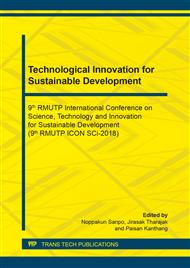p.230
p.239
p.246
p.253
p.263
p.269
p.275
p.280
p.292
Design and Construction the RF Ion Source for Compact Accelerator with 30 keV Energy
Abstract:
In constructing the low energy accelerator for plant modification the most important part is the ion source. In the conventional cold cathodes and hot filament ion source methods the filament continuously burns out over time, has a shorter lifespan and requires venting of the ion source to atmosphere. Henceforth the Radio frequency (RF) antenna ion source or “non-thermionic ion source” with 13.6 MHz was used in the accelerator as well as it being easy to generate varie the plasma souce and stability. This ion source can produce a particle beam of about ~30 to 40 mA current. The ion particle was extracted by the first zero voltage extraction rod electrode method focusing the ion beam of 0-30 kV with the second rod electrode after which the third rod electrode has zero voltage. In calculating and designing this system via the Simion8.0 Program, the result showed that the Ar+ ion beam with 30 keV can be focused with 1 cm diameter beam at the distance of 10 cm of the drift space.
Info:
Periodical:
Pages:
263-268
Citation:
Online since:
May 2019
Authors:
Keywords:
Price:
Сopyright:
© 2019 Trans Tech Publications Ltd. All Rights Reserved
Share:
Citation:


